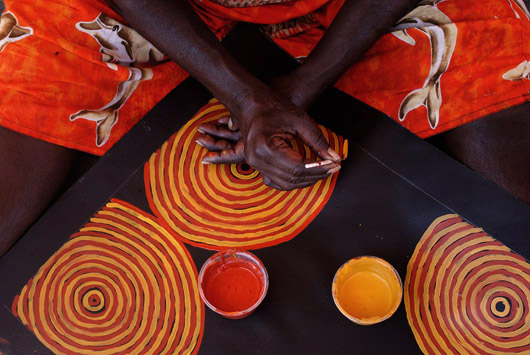A.bc
In Australia, sulle tracce di Chatwin 20 anni dopo Le Vie dei Canti
Palazzo delle Esposizioni, Roma
A.bc
In Australia, in Chatwin's footsteps 20 years after The Songlines Palazzo
Delle Esposizioni, Rome


Puntinature cromatiche, forme minimaliste, semplici acquerelli. Astrazioni
simboliche, strutture intricate, tendenze figurative. Agli occhi del visitatore
di passaggio, la pittura è l’ambito in cui sembra che gli
aborigeni si esprimano con più felicità. Un fatto sociale
che appare trasversale. Si va dal dilettante che prova a fare il salto
sul mercato agli artisti riconosciuti a livello internazionale che fanno
registrare vendite milionarie, fino a chi si improvvisa pittore per piazzare
qualche patacca all’ingenuo di turno. Racconti del sogno, trasmissione
di tradizioni, ma anche business. Chatwin stesso dedica un capitolo non
tenero ad alcuni “mercanti d’arte aborigena” di Alice
Springs. Vi sono diverse cooperative e associazioni che organizzano il
lavoro degli artisti aborigeni, spesso con whitefella (bianchi) in posti
chiave. Ad Alice la Ngurratjuta Pmara Ntjarra Corporation raggruppa una
trentina di artisti tra cui Lennie Namatjira, nipote di Albert Namatjira,
il più importante pittore aborigeno. Dipinge accanto alle compagne,
sedute per terra a gambe incrociate, chine su tele e vernici acriliche
che hanno sostituito i pigmenti naturali e il corpo o la pietra. Racconta
del suo stile, finisce per parlare del nonno che continua a ispirarla.
Per il valore della sua arte, lodata anche dalla regina d’Inghilterra,
e la fama acquisita, Albert fu il primo aborigeno ad avere la cittadinanza
australiana, nel 1957. Ma le cose cambiarono rapidamente. Venne accusato
di fornire alcol illegalmente, perché da libero cittadino comprava
ogni tanto da bere agli amici secondo la consuetudine comunitaria. Rivendicò
la sua innocenza, ma fu condannato a sei mesi. Uscito dopo due mesi di
prigione, cadde in depressione e non dipinse più. Si spense qualche
mese più tardi, a 55 anni, per un attacco di cuore
Lennie Namatjira, nipote di Albert Namatjira

Lennie Namatjira, nipote di Albert Namatjira

Dot
painting, symbolic abstractions, rich chromatism, minimalist shapes, simple
watercolours. In the eyes of passing through visitors, painting is where
it seems that Aboriginal people express themselves at their best. A social
fact that is transversal. The painters range from amateurs trying to make
it on the market, to internationally recognised artists who record very
high sales, to those who turn painters just to place some piece of junk
to the first gullible person at hand. Dreaming Time tales, passing over
of traditions, but also business. Chatwin himself dedicates a hard chapter
of his Songlines to some of Alice Springs Aboriginal art merchants. There
are various art cooperatives which organize the work of Aboriginal artists,
often with whitefella in key places. In Alice Springs the Ngurratjuta
Pmara Ntjarra Corporation assembles about 30 artists, including Lennie
Namatjira, nephew of Albert Namatjira, the most important Aboriginal painter.
She paints next to her companions, sitting on the floor cross-legged,
bent on canvas and acrylic paints that have replaced the natural pigments
and the body or the stone. She tells about her style, she ends up by speaking
of her grandfather who continues to inspire her. For the value of his
art, even praised by the Queen of England, and the fame he gained, Albert
was the first Aboriginal to obtain Australian citizenship in 1957. But
things changed quickly. He was accused of providing alcohol illegally,
because as a free citizen he occasionally bought his friends a drink in
accordance with the customs of his community. He claimed his innocence,
but he was sentenced to six months. Released after two months of jail,
he fell into depression and did not paint more. He died a few months later,
at the age of 55, of a heart attack
Lennie Namatjira, nephew of Albert Namatjira
Lennie Namatjira, nephew of Albert Namatjira